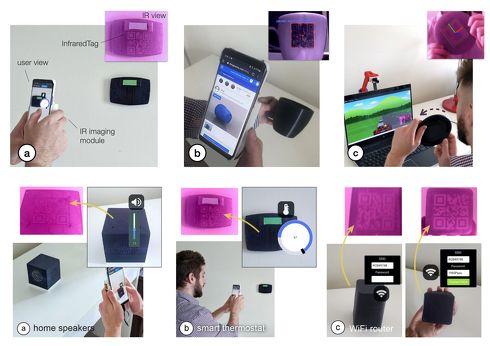The QR code is invisible to the naked eye, but can be seen through an infrared camera.

``InfraredTags: Embedding Invisible AR Markers and Barcodes Using Low-Cost, Infrared-Based 3D Printing and Imaging Tools'' developed by a research team from MIT CSAIL and Facebook Reality Labs (currently Meta Reality Labs) is a 3D object It is a technology that embeds tags inconspicuously inside. Two-dimensional tags that are invisible to the naked eye, such as QR codes, ArUco markers, and barcodes, can be embedded and read through an infrared camera. [Image] Reading hidden codes and markers with an infrared camera makes it possible to operate home appliances, etc. Research proposes a method of embedding markers and barcodes in the shape of objects without the need for complicated processing or expensive imaging equipment. do. This is achieved by modeling with a commercially available Fused Deposition Modeling (FDM) 3D printer and a commercially available infrared (IR) transmissive filament, and using a commercially available near-infrared camera for detection. The main shape of the object is 3D printed with IR filament, and the tag itself is created leaving a gap for the bit. Since the main shape is semi-transparent in the infrared region, a near-infrared camera can see through it and photograph the markers, which appear at different intensities in the image. With this, the target infrared tag can be read. Multiple tags can be embedded within an object, allowing scanning from multiple angles while allowing for partial occlusion. In order to embed tags into 3D objects, we built a user interface that allows users to read tags into the editor and place them in any position. We also created an image processing pipeline to identify tags embedded inside 3D prints. In the experiment, the tag was successfully detected from a distance of 250 cm with a weak near-infrared light (0.2 lux). In order to detect infrared tags with conventional smartphones, we created a small module that can be attached to existing mobile devices and added a near-infrared imaging function. With this, when a user takes a picture with a smartphone, a custom image processing pipeline detects tags, boosts contrast, remotely controls home appliances and devices in an AR environment, and retrieves Wi-Fi network names and passwords. New interactions with 3D objects are possible, such as input by simply reading or using existing objects as game controllers. * Written by Hiroki Yamashita, who presides over the web media "Seamless" that introduces the latest research in technology. Mr. Yamashita picks up highly novel scientific papers and explains them.
ITmedia NEWS






![[New Toyota Voxy (90 series)] Amplifies the characteristics of the aero body! A design that further enhances the power of the front mask! #Works direct custom deep layer 001](https://website-google-hk.oss-cn-hongkong.aliyuncs.com/drawing/article_results_9/2022/3/25/01568e2fbf021c0eaf7d013507c850a4_0.jpeg)

![[Toyota Noah / Voxy new model] Modellista releases various customized parts ... Actual vehicle exhibited at Tokyo Auto Salon](https://website-google-hk.oss-cn-hongkong.aliyuncs.com/drawing/article_results_9/2022/3/25/8268612c1e5941e62d3dfd07f8991b2f_0.jpeg)
